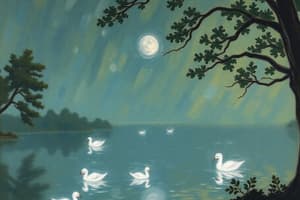Podcast
Questions and Answers
What auxiliary verb is used to form the present continuous tense?
What auxiliary verb is used to form the present continuous tense?
- Go
- Do
- Be (correct)
- Have
Which of the following is an example of a positive statement in the present continuous tense?
Which of the following is an example of a positive statement in the present continuous tense?
- I am planning a trip (correct)
- They are not playing soccer
- He is never reading books
- She is rarely singing at the concert
Which of the following is NOT a use of the present continuous tense?
Which of the following is NOT a use of the present continuous tense?
- Describing actions happening at the moment of speaking
- Talking about the past events (correct)
- Discussing actions repeating over time
- Describing temporary actions
How are negative statements formed in the present continuous tense?
How are negative statements formed in the present continuous tense?
Which verb ending is added to the main verb in the present continuous tense?
Which verb ending is added to the main verb in the present continuous tense?
What is the auxiliary verb used in forming questions in the present continuous tense?
What is the auxiliary verb used in forming questions in the present continuous tense?
What is added to the main verb in forming the present continuous tense?
What is added to the main verb in forming the present continuous tense?
What type of statements can the present continuous tense be used in?
What type of statements can the present continuous tense be used in?
What is the present continuous tense used to describe?
What is the present continuous tense used to describe?
What is the present continuous tense used to describe, aside from actions happening at the moment of speaking?
What is the present continuous tense used to describe, aside from actions happening at the moment of speaking?
Flashcards are hidden until you start studying
Study Notes
The present continuous, also known as the present progressive tense, is a verb tense used to talk about actions or events that are happening at the moment of speaking. It is created by using the verb "to be" in its present tense form (am, is, are) and adding the present participle (an action verb ending in "-ing") to the main verb. The present continuous can be used to describe actions that are happening right now, temporary, repeated, will happen in the future, or have already started.
Form
The present continuous tense is formed by using the auxiliary verb "to be" in its present tense form (am, is, are) and adding the present participle (-ing) to the main verb. For example, "I am reading" or "They are eating."
Usage
The present continuous tense is used to talk about actions or events that are happening at the moment of speaking. It can also be used to describe actions that are temporary, repeated, will happen in the future, or have already started.
Positive Statements
Positive statements in the present continuous tense are used to describe actions or events that are happening at the moment of speaking. For example, "I am reading a book," "They are playing soccer," or "He is writing an email."
Negative Statements
Negative statements in the present continuous tense are formed by adding "not" after the auxiliary verb "to be" in its present tense form. For example, "I am not playing the piano," "They are not watching TV," or "He is not drinking coffee."
Questions
Questions in the present continuous tense are formed by inverting the auxiliary verb "to be" and adding the present participle (-ing) to the main verb. For example, "Am I working?" "Are they studying?" or "Is he laughing?"
In conclusion, the present continuous tense is a versatile verb tense that allows us to describe actions or events that are happening at the moment of speaking, as well as those that are temporary, repeated, will happen in the future, or have already started. It is formed by using the verb "to be" in its present tense form and adding the present participle (-ing) to the main verb. The present continuous tense can be used in both positive and negative statements, as well as questions.
Studying That Suits You
Use AI to generate personalized quizzes and flashcards to suit your learning preferences.




